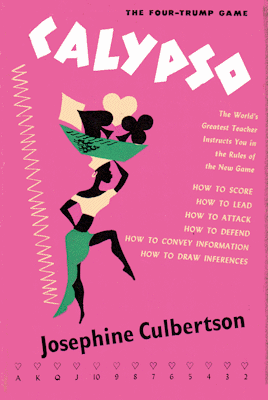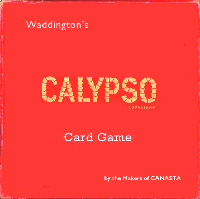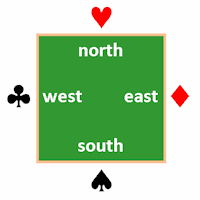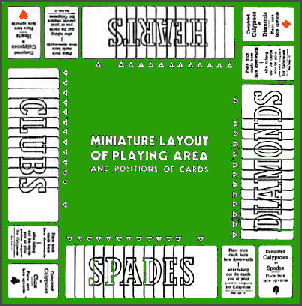Calypso is not so much an historic game (yet) as a "forgotten" one from the mid
20th century, and is included here because it has always struck me as worthy of rescue
from an undeserved neglect. So far as I know, the only remaining regular players
are to be found in Western Massachusetts, where (according to my correspondent Mark Paul)
it is played by a few clubs on a regular basis. Of all "invented" card games not
invented by me, Calypso is the one I most enjoy, and most wish I had thought of first.
It was in fact invented by one R W Willis of Trinidad, and further developed by
the English international Bridge player
Kenneth W. Konstam. In his book on the game published in 1954, Konstam recounts the story
thus:
In October 1953, Mr. R. W. Willis and his wife were spending a holiday in this country and through a mutual friend I was told that Willis had invented a new card game which he and his friends were playing at home in Trinidad. Being of a curious disposition... I arranged an introduction at which we all sat down and played what I firmly believe to be the first game of Calypso ever played other than at Mr. Willis' home. What is more surprising I found myself fascinated by it. The rules as we played on that first afternoon were cumbersome and the game itself too "busy"... [T]oo many cards were lying about the table at one time and too many different scoring combinations existed. But nevertheless I enjoyed it. I liked the idea of having my own personal trump and of occasionally being able to winkle from my opponent his Ace with my Jack.
There were novel features which I had never met in any other game and... [w]hen Mr. Willis left me I asked him for the option to develop his game and bring it out in such a way that I thought would appeal to the card-playing public. I am grateful to Mr. Willis for his confidence and trust and believe that he is now satisfied with the evolution of his brain child. By turning Calypso into a partnership game and changing many of the scoring combinations I tried out the game on my friends, apologetically at first, but more boldly later on as I discovered that strange as it may seem no one became bored and even non card-players learnt the rules in the minimum amount of time...
I have played Calypso with expert card players, with keen card players and with novices. In every case it has proved an enjoyable recreation, a possible gamble and a first class test of skill. I boldly prophesy that others will look on it in the same light.

"The four-trump game",
by Josephine Culbertson
Konstam's boldness and reputation were enough to persuade the British card-manufacturers Thomas de la Rue and John Waddington Ltd to publish Calypso in the form of a boxed set including four packs of cards, trump indicators, and a book of the inevitably "official" rules. No doubt all concerned believed this would be the next fad game, perhaps to knock off its perch the then fashionable and relatively novel game of Canasta. Alas for all concerned, not least for Konstam's all-too-bold prophecy, this desirable outcome was not to be.
Why not?

Waddington's boxed Calypso set
One possibility was that Canasta was still in full flood and not yet ready to be
knocked off its perch - a few years' wait might have proved beneficial. Another is that
the game's ingenious system of "personal trumps" is not quite as intuitively
accessible as Konstam believed; and some players may have been put off by the necessity of
permanently maintaining and replacing four packs of (ideally) identical cards. There will, of
course, be those who maintain that it simply isn't a very good game; but that is surely a
matter of opinion, and I'm happy to avow it isn't mine. Disconcertingly odd at first play it
may well be, but I have found it highly rewarding of perseverance.
In America Calypso was published by the United States Playing Card Company and promoted by notable Bridge experts such as Ewart Kempson, Josephine Culbertson (book cover, left), Geoffrey Mott-Smith, and Alphonse Moyse, Jr.
- Players
- Calypso is played by four in fixed partnerships. See below for the non-partnership version for three or four players.
- Cards
- Use four 52-card packs, preferably of identical back design and colour, and necessarily all the same size, weight, and finish. Shuffle them together very thoroughly before play. Cards rank AKQJ1098765432.
- Partners and seats
- The players

Seating positions and
personal trumps cutting the two highest cards are partners against the two lowest, and sit opposite each other. Whoever cut highest has first choice of seats and personal trump suit. That player's partner will sit opposite and have as personal trump the partnering suit of the first player, such that one partnership's suits are spades and hearts and the other's clubs and diamonds. (See diagram.) (The illustrated association of specific suits with specific seats is customary - only a serving suggestion - not legally binding.) - Deal
- A game consists of four deals, one by each player. Whoever cut the highest card deals first and the turn to deal subsequently passes to the left. Deal 13 cards each face down in ones, and stack the remainder face down to one side. These will gradually be used up in subsequent deals.
- Object
- To win tricks and make calypsos from the cards they contain. A calypso is a complete
run of 13 cards of the same suit from Ace down to Two. Specifically, your aims are -
- to build calypsos in your personal trump suit,
- to help your partner build calypsos in his or her own suit, and
- to hinder your opponents from building calypsos in theirs.
- Trick-play
- The player at dealer's left leads to the first trick, and the winner of each trick
leads to the next. You must follow suit if you can, but may otherwise play any card.
The rules of trick-taking are:
- If you lead a card of your personal trump suit, and everyone follows suit, you win the trick regardless of rank. However, if anyone can't follow suit and instead play a card of their own personal trump, then the trick is taken by the highest-ranking personal trump played.
- If you lead from any other suit, then the trick is taken by the highest card of the suit led, or (if different) by the highest personal trump if any are played.
- If the trick is being taken by two identical cards, or by personal trumps of different suits but equal rank, then the first such card wins.
- Building calypsos
- When you win a trick,

Arrangement of calypsos and
unused won cards you extract from it any cards you need towards building your current calypso, and pass to your partner any cards needed for theirs. You then stack any unused cards face down on a pile of won cards belonging to your partnership. Unused cards will be both those of your opponents' suits, and those of your own side's suits that duplicate cards already contained in calypsos under construction. Konstam's diagram (right) shows each player's calypso under construction. To the right of South's current calypso is the face-down stack of unused cards won by South in tricks, and to the right of that a pile of completed spade calypsos, face up.) - Completing calypsos
- When you complete a calypso you bunch all its cards together and stack them face up on the table at your right-hand corner like a won trick. You may then start building a new one, and for this purpose are allowed to use any valid cards in the trick you just won. (This is the exception to the rule about not being able to use duplicates won in the same trick.)
- Ending and scoring
- When thirteen tricks have been played, the next 13 cards are dealt by the player to the
left of the previous dealer. Play continues in the same way until four deals have been
completed. Each side then scores as follows:
item score For each partner's first calypso 500 For each partner's second calypso 750 For each subsequent calypso 1000 For each card in an unfinished calypso 20 For each unmelded card won in tricks 10 - Revokes
-

Unfollowed suit indicators, one set per player A revoke occurs when a player fails to follow suit although able to do. The penalty for a revoke is the addition of 260 points to the score of the non-offending side.(It is set high because a revoke could lead to the loss of a complete calypso to the offended side. In trick-taking games like Bridge where all the cards are dealt out it is usually obvious when a revoke is committed, but in Calypso, where there are four times as many cards and not more than a quarter of them are in play at any given time, it helps to provide some way of marking who has failed to follow suit in case they do play from that suit to a later trick in the same deal and nobody notices. Konstam recommends that each player be equipped with four indicator cards, as illustrated (above) for the spade player. These are kept face down till their owner fails to follow suit, when the card showing the suit renounced is turned face up for the rest of the deal.)
In most trick-taking games you lead to a trick from either the trump suit or a plain suit. In Calypso, however, you are always leading from a trump suit - not necessarily your own - and you have in fact three choices. Whether to lead your own trump, your partner's trump, or either of the adverse trumps, calls for a radically different approach from what you may be used to.
Probably the most important piece of advice is to avoid leading from your own suit just for the sake and novelty of winning an easy trick. The danger of doing so is that if an opponent follows with a duplicate of the card you lead, or any other card played to the trick, or any rank already represented in the calypso you are currently constructing, you will thereby be deprived of a whole calypso, as the duplicated card can only be added to your pile of won cards.
This doesn't mean to say that you should studiously avoid leading from your own trump. It can be a good opening gambit at the start of a deal if you hold between three and six of your own suit and have no particularly short suit elsewhere. It may also be helpful if you have only low-ranking personal trumps and are unlikely to be able to take tricks with them later when opponents get the lead.
It is rarely a good idea to lead your partner's trump, especially early in the deal, as there is no guarantee that your partner holds high enough cards of that suit to be able to win the trick. But it may be worth doing so if you have certain trick-winners in that suit, or if you are void or have only one of it, so that you may be able to trump when the suit is led again.
As for leading adverse trumps, it is generally best to lead high rather than low.
Calypso for four with everyone playing for themselves, although apparently the original game, is pretty pointless; for if there is no requirement to give anyone else cards for their own calypsos it will be quite surprising for anyone to complete more than one.
Rather more promising is Calypso for three. In the official version, you simply omit one of the suits (conventionally spades) and play for yourself. "In both [non-partnership] games", says Kempson, "players who cannot help themselves should endeavour to give help (however grudging) to the player who is farthest in arrears."
In an earlier version of this page (May 2009) I offered another method of three-handed play which at the time I had not tested. Having since tested it and found it unsatisfying I have now removed it. More workable is to play the "official" version described above, but in what I call "split partnership" format. This simply means that, at the end of the game, you each score for everything made by yourself and the player on your right.




